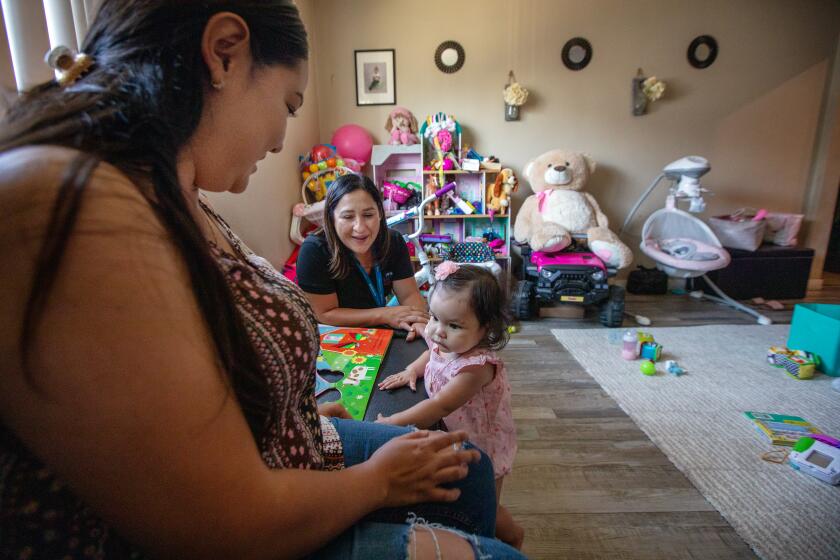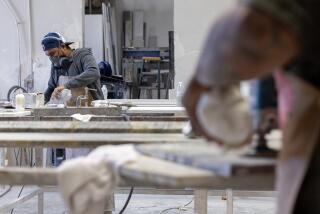Engineered stone counter tops are killing workers at high rates. What can consumers do about it?

- Share via
Silicosis, a lung disease associated with the exposure to crystalline silica, has been afflicting young workers, primarily Latino immigrants who are exposed to the silica dust when workers are cutting and grinding engineered stone counter tops.
“It’s an old disease, but what we’re seeing is the silicosis from engineered stone is happening much faster and affecting people quicker and more severely than other products,” said Dr. Sheiphali Gandhi, a pulmonologist at UC San Francisco School of Medicine.
But healthcare experts say there are ways consumers can help tackle the problem by questioning the safety standards used by manufacturers and by choosing alternative counter top materials.
Gandhi recently was co-author of a report that found that the disease has targeted workers, largely Latino immigrants, in their 20s, 30s or 40s but some were often diagnosed later in life after being exposed for decades.
The booming popularity of countertops made of engineered stone has driven a new epidemic of silicosis, an incurable lung disease, researchers have found.
Engineered stone is a manufactured composite material made up of crushed stone that contains more than 90% silica, according to the California Department of Industrial Relations.
That compares with natural counter top material like marble that’s predominantly calcium-based, which means the silica content is less than 5%, Gandhi said. Granite, another natural material, on average has 25% to 30% silica content.
Gandhi’s co-author Dr. Jane Fazio, a pulmonary critical care physician at UCLA Medical Center, said engineered stone has dominated the market in the last 10 to 15 years primarily because of its affordability.
However, when the material is being cut and ground — even if the fabrication center requires workers to wear masks and use a water suppression method to help keep dust to a minimum — the high silica content can harm workers, Gandhi said.
“Our study demonstrates that there is no other cause of the type of lung disease that they have other than the silica that they’re breathing,” she said, adding that “the average consumer would be absolutely horrified to know how dangerous silica is for workers.”
Here’s what you should know about buying an engineered stone counter top and the steps you can take to help protect workers who work with material:
Should I be worried about my counter tops?
There’s no need to be worried about the finished counter tops already installed in your home.
It’s important that consumers understand that engineered stone counter tops are an occupational safety issue and consumers “should not shy away from using stone products whether they’re man-made or natural,” said Jim Hieb of the Natural Stone Institute, a trade association for the natural stone industry.
The Engineered Stone Manufacturers Assn. added that many engineered stone products are certified to ensure their safety for installed use, including certification by the National Science Foundation and Greenguard, an independent certification program.
“Millions of engineered stone countertops have been installed in consumers’ homes for nearly 40 years without posing any risk,” according to the Engineered Stone Manufacturers Assn.
The material isn’t inherently dangerous when it’s left alone but consumers shouldn’t let workers cut, grind or polish the engineered stone inside their home, said Bob Blink, past president of the Western Occupational and Environmental Medical Assn.
“When you disturb it and create fine dust from it, then it becomes dangerous because you’re getting small particles in the air, you can breathe it in, and it can get into your lungs,” Blink said.
If the counter tops are cut or sanded in the home, the consumer can be exposed to a small amount of silica but the workers face the most serious health problems, Gandhi said.
Another potential risk could come from living close to a manufacturing or fabrication plant. Gandhi said cutting is constantly happening outside and people who live in close proximity could face exposure.
What can the consumer do?
Gandhi recommends consumers research whether they want the product in their home, “knowing the repercussions on workers.”
Gandhi also suggests that consumers look for a fabrication shop that sells refurbished counter tops.
Consumer demand drives most industries and she said if consumers choose not to buy engineered stone because of the risk it poses for workers, that can push research to make the product safer or encourage stronger safety enforcement on the manufacturers.
California’s tobacco tax funds resources for young kids. But with sales declining and a flavored tobacco ban in place, First 5’s child programs are at risk.
“That’s the power the consumer has, the more the consumers ask these questions, the more the renovators will realize that people care about these issues and will put money into improving the conditions,” Gandhi said.
Getting straight answers can be difficult because the kitchen remodeling stores where consumers buy the counter tops may not be the same company that contracts the installation work, Fazio said.
While researching the fabrication shop or manufacturer, Heib suggested consumers visit the location if that’s an option.
Another potential research source is the California Division of Occupational Safety and Health website. Consumers can see whether a company has received a citation from CAL-OSHA.
Gandhi said CAL-OSHA’s ability to do air monitoring and testing at every one of these shops is limited.
“Usually they’re mostly concentrated on shops where they have been recorded as unsafe, so people can see if there have been any citations but it’s not [a resource] you can rely on,” she said.
More to Read
Sign up for Essential California
The most important California stories and recommendations in your inbox every morning.
You may occasionally receive promotional content from the Los Angeles Times.
















